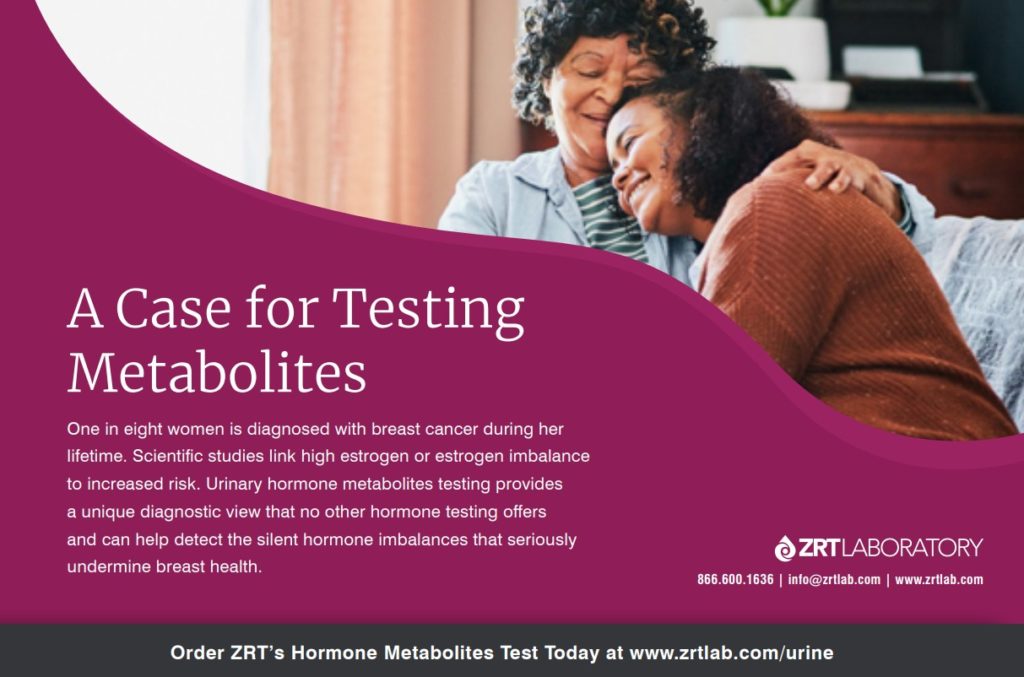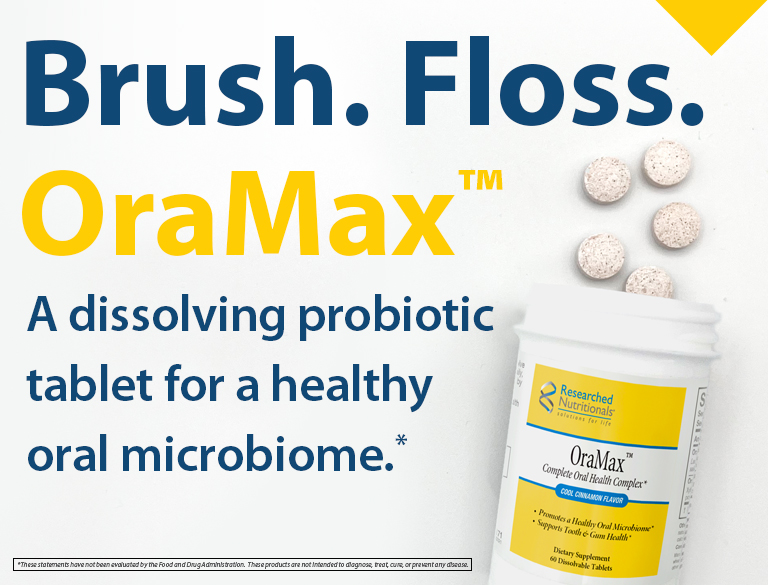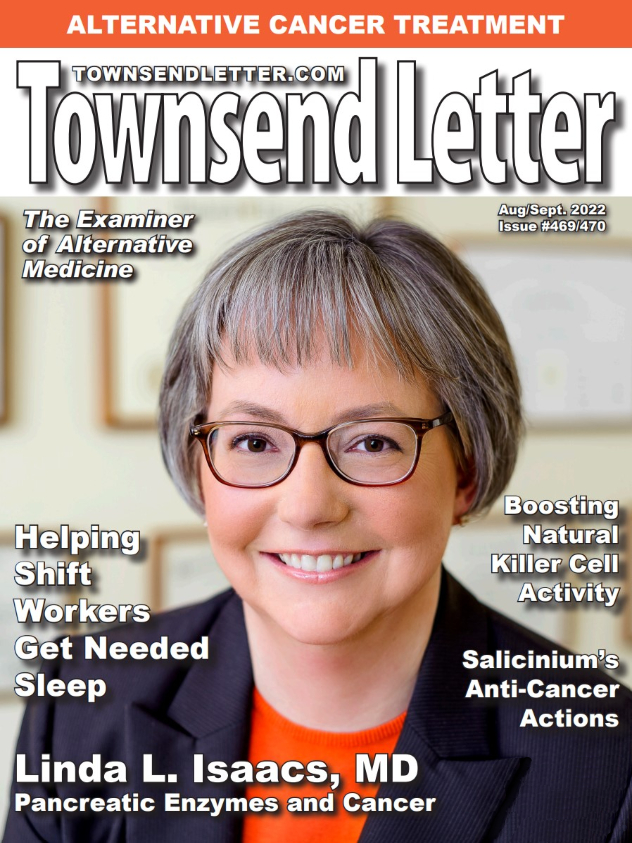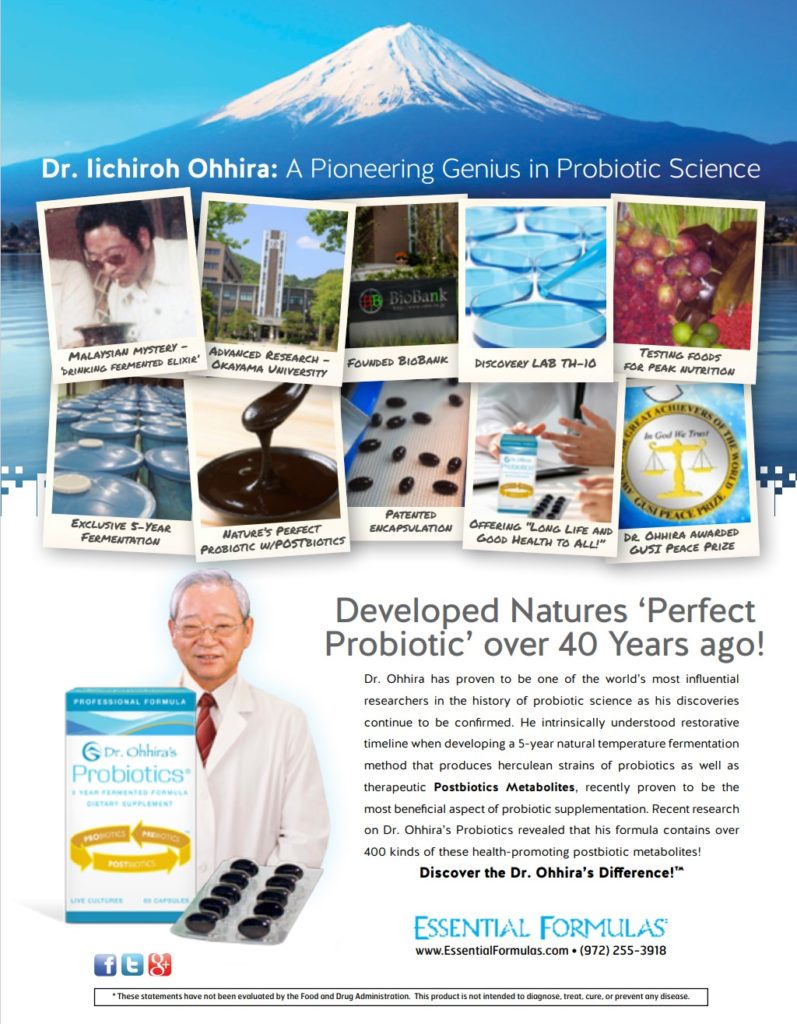By Linda L. Isaacs, MD
For the past 30 years, I have offered an enzyme-based nutritional program to patients with cancer and other illnesses. It is both rewarding and challenging work. There are some days that vividly remind me why I have persevered through all these years.
In early 2022, I got a call from a former patient of my long-time colleague and friend, the late Nicholas Gonzalez, MD. This patient was diagnosed with squamous cell carcinoma of the lungs in late December 2009; the cancer had spread to his bones. The orthodox treatment available at the time had little to offer him. He heard through a friend of the program offered by Nick and me, and he became Nick’s patient in January 2010. A year later, scans showed the tumors were gone. Nick published his case in 2014 as part of his article about the use of pancreatic enzymes in cancer.1 When I spoke to the patient, he told me that there was no sign of the lung cancer that had been diagnosed more than a decade earlier.
Prior to Nick’s death in 2015, the patient had agreed to an interview for a documentary, which was later televised. Another man and his wife saw that documentary, shortly after he was told that his colon cancer had returned; surgery and chemotherapy had not cured him. He contacted me and became my patient. Now, he has no sign of cancer on multiple follow-up scans. His oncologist is amazed. The details of his case are included in an article I wrote for Alternative Therapies in Health and Medicine.2 The patient himself told his story in an interview in the Price-Pottenger Journal of Health & Healing, mentioning how grateful he is for the time he has had with his family, especially his son.3
When Nick’s patient called, I was able to tell him that because he had diligently followed his treatment plan and then shared his story, another man was inspired to diligently follow the program I gave him. And a ten-year-old boy did not have to attend his father’s funeral.
That is the kind of story that keeps me going. That is the kind of story that got me involved in the first place. When I was a third-year medical student, the intern for my internal medicine rotation was Nick Gonzalez. Even with the rigors of medical internship, he was continuing his investigation of the results of William Donald Kelley, the orthodontist and alternative cancer practitioner who had become notorious for his involvement in the treatment of Steve McQueen. Nick found multiple cases of patients who had done well in Kelley’s files.
I still remember the impact some of those cases had on me when I heard about them for the first time. A man with prostate cancer in multiple bones, admitted to the hospital for pain relief, who went on the Kelley program and 10 years later was working part-time and playing the violin in a ragtime band. A woman with metastatic uterine cancer whose lung tumors resolved. A woman who had bilateral mastectomies before she was forty, and painful recurrence in the bone a few years later, who was alive and pain-free 17 years later (and who was still alive and well in 2016, 40 years after the recurrence). All of these cases and more are in Nick’s monograph about Kelley, One Man Alone.4 Nick and I both dedicated our professional lives to doing what we could to get this method properly investigated. Between the monograph about Kelley’s results and our own efforts, we published more than 150 case reports describing patients with documented tumor regression, prolonged survival, or both.1,2,4-9
What is the method? It involves three components: dietary modification, nutritional supplements, and detoxification routines such as coffee enemas. All three components are important, but we believe the anti-cancer effect comes from large doses of pancreatic enzymes, taken away from meals.
The use of pancreatic enzymes for cancer goes back a century, beginning with the observations of the embryologist John Beard. Beard noted the similarity of the appearance and behavior of cancer to that of the precursor to the placenta, the trophoblast. The trophoblast invades the uterine wall, creates a blood supply for itself, and evades the maternal immune system, looking and acting like cancer does. But at a certain point in development, the trophoblast matures, becoming less invasive. Beard reported that this happened around the same time that the fetus began producing pancreatic enzymes, months before birth. He postulated that pancreatic enzymes played a role in controlling the behavior of trophoblast cells, and that they could also play a role in controlling the behavior of cancer cells, as described in his 1911 book The Enzyme Treatment of Cancer and Its Scientific Basis.10
A 2022 review article of mine, published in Integrative Cancer Therapies, details the history of the clinical use of pancreatic enzymes against cancer in the decades after Beard published his theories.11 In addition, the article discusses possible mechanisms of action on a cellular level. While for many years it was believed that pancreatic enzymes only have a role in digestion, in more recent years there has been an explosion of discoveries about the role of proteases (a class of enzymes that cleave proteins) in multiple aspects of physiology.12 There are protease-activated receptors on the surfaces of many different types of cells, including cancer cells and trophoblast cells, where various proteolytic enzymes can affect the behavior of cells by clipping off surface receptors.13,14
There is reason to believe that the active agent against cancer is not the activated forms of the various proteolytic agents, but rather the proenzyme (inactive precursor) forms, based on research done in cell cultures.15,16 The form of pancreas product that Nick and I used is minimally processed, and most of the enzymes it contains are in the precursor form.
While general theories about the action of pancreatic enzymes on cancer cells do exist, the exact mechanisms are not as detailed as some patients and practitioners desire. As an example, after a lecture, an attendee wanted to know what action pancreatic enzymes have on the p53 system and looked surprised and disappointed when I told him that as far as I know, no one has investigated this.
Kelley started using pancreatic enzymes for cancer based on a serendipitous discovery when he himself became ill, not based on an elaborate theory of their mechanism of action. Nick and I began using this treatment method based on patient histories in Kelley’s files, not based on an elaborate mechanism of action. Our focus was on clinical results. For that reason, we preserved all the aspects of Kelley’s methods, including coffee enemas, which are commonly regarded with derision in the orthodox medical world—through coffee enemas have a long history of use, as described in my review article on that subject.17
Beard’s theories about cancer treatment were based on his observations about the fetus’ manufacture of pancreatic enzymes around the time the trophoblast matured into the placenta. But Beard was not the first to notice that cancer looks and acts like embryonal tissue. In his 1914 book The Cancer Problem, Bainbridge, a surgeon based in New York City, discusses the concept of “embryonic rests,” residual embryonic cells in adult tissues that give rise to cancer, proposed by Cohnheim in 1882.18 Bainbridge dismissed the theory, though he did not elaborate on his reasons. Around the same time, Boveri suggested that cancer was caused by changes in a cell’s nuclear material, recognized as the source of inherited information even though the exact nature of chromosomes had not been determined.19 This gave rise to the Somatic Mutation Theory, the predominant theory about carcinogenesis in the medical world today, informing decisions about research goals and treatment methods in both the orthodox and alternative medical worlds.

The Somatic Mutation Theory states that cancer arises because of a mutation or collection of mutations in a mature somatic cell or in a stem cell, causing it to become a cell that proliferates and spreads. In the mindset based on the Somatic Mutation Theory, such mutated cells can only be treated by eradicating the defective cells, since nothing can fix such a mutation. Surgical removal, destruction by radiation, chemotherapy, or immunotherapy, or poisoning by affecting altered metabolic pathways are the only tools that can possibly work.
Alternate explanations of the development of cancer exist. The Tissue Organization Field Theory (TOFT), as expounded by Drs. Soto and Sonnenschein, states that chronic abnormal interactions between the stroma and cells in the tissues, such as in chronic inflammation, can affect cells to become more primitive in nature, “development gone awry” as the authors put it.20 As cells become more primitive, their metabolism changes to become more similar to that of the early embryo, and they develop genetic instability. In this model, genetic mutations occur in cancer not as a cause, but as a consequence of the shift towards a more primitive phenotype. The authors compare the two models, Somatic Mutation and Tissue Organization Field, with their weaknesses and strengths, in a table that can be accessed at https://journals.plos.org/plosbiology/article/figure?id=10.1371/journal.pbio.3000670.t001. The most salient point in this table to me is this statement: “’Spontaneous cancer regression’ is compatible with the TOFT. Tissue recombinants show that cancer cells (even of those carrying alleged “oncogenic” mutations) are ‘normalized’ when placed in homotypic “normal” tissues.”
Beard’s theory would suggest that pancreatic proenzymes control the aggressive behavior of the trophoblast, an early embryonic cell. If the Tissue Organization Field Theory is correct, then cancer consists of cells that have shifted towards more primitive behavior, and pancreatic proenzymes may normalize these cells and control their behavior. Some experimental support for this exists; Peran et al reported that a combination of proenzymes and amylase promoted cellular differentiation.21
TOFT also provides a theoretical underpinning for Nick’s and my clinical observation that pancreatic proenzyme treatment alone, without diet and detoxification, is usually not effective. If cancer develops because of issues in the tissues such as chronic inflammation, a good quality diet can lessen that inflammation. Meanwhile, poor diets, continued toxin exposure, or even negative emotional states could mean increased stressors in the tissues causing the production of more abnormal cells, overwhelming the proenzymes’ ability to nudge those cells into better behavior.
I have written before in the Townsend Letter about the challenges that Nick and I faced as we attempted to conduct clinical research on the use of proteolytic enzymes in cancer.22 Since those bleak times in the 1990s, more and more evidence has appeared in the medical literature about the role of proteases in physiology that would support their use. It is my hope that in the long run, Nick’s efforts and mine will be vindicated.
References
1. Gonzalez NJ. The history of the enzyme treatment of cancer. Altern Ther Health Med. 2014;20(Suppl 2):30-44. Available at: http://alternative-therapies.com/at/web_pdfs/S202Gonzalez.pdf.
2. Isaacs LL. An enzyme-based nutritional protocol in metastatic cancer: case reports of a patient with colon cancer and a patient with lung cancer. Altern Ther Health Med. 2019;25(4):16-19. Available at: https://www.drlindai.com/Alt-ther-7-2019.pdf.
3. A patient’s story: experiencing a renewed sense of energy. Price-Pottenger J Nutr Healing. 2021;45(4):10. Available at: https://price-pottenger.org/gift-of-health/.
4. Gonzalez NJ. One Man Alone; An Investigation of Nutrition, Cancer, and William Donald Kelley. New York, NY: New Spring Press; 2010.
5. Gonzalez NJ. Conquering Cancer: Volume One. New York, NY: New Spring Press; 2016.
6. Gonzalez NJ. Conquering Cancer: Volume Two. New York, NY: New Spring Press; 2017.
7. Gonzalez NJ, Isaacs LL. Evaluation of pancreatic proteolytic enzyme treatment of adenocarcinoma of the pancreas, with nutrition and detoxification support. Nutr Cancer. 1999;33(2):117-124. doi: 10.1207/S15327914NC330201
8. Gonzalez NJ, Isaacs LL. The Gonzalez therapy and cancer: a collection of case reports. Altern Ther Health Med. 2007;13(1):46-55. Available at: http://www.alternative-therapies.com/at/web_pdfs/gonzalez1.pdf.
9. Isaacs LL. Linitis plastica gastric cancer: a case report. Townsend Letter. 2016;397:68-69.
10. Beard J. The Enzyme Treatment of Cancer and Its Scientific Basis. London: Chatto and Windus; 1911.
11. Isaacs LL. Pancreatic proteolytic enzymes and cancer: New support for an old theory. Integr Cancer Ther. 2022;21:15347354221096077. doi: 10.1177/15347354221096077. Available at: https://journals.sagepub.com/doi/full/10.1177/15347354221096077.
12. Verhamme IM, Leonard SE, Perkins RC. Proteases: pivot points in functional proteomics. Methods Mol Biol (Clifton, NJ). 2019;1871:313-392. doi: 10.1007/978-1-4939-8814-3_20. Available at: https://www.ncbi.nlm.nih.gov/pmc/articles/PMC6472488/.
13. Bar-Shavit R, Maoz M, Kancharla A, et al. Protease-activated receptors (PARs) in cancer: Novel biased signaling and targets for therapy. Methods Cell Biol. 2016;132:341-358. doi: 10.1016/bs.mcb.2015.11.006. Available at: https://www.ncbi.nlm.nih.gov/pubmed/26928551.
14. Even-Ram SC, Grisaru-Granovsky S, Pruss D, et al. The pattern of expression of protease-activated receptors (PARs) during early trophoblast development. J Pathol. 2003;200(1):47-52. doi: 10.1002/path.1338
15. Novak JF, Trnka F. Proenzyme therapy of cancer. Anticancer Res. 2005;25(2A):1157-1177. Available at: https://ar.iiarjournals.org/content/anticanres/25/2A/1157.full.pdf.
16. Peran M, Lopez-Ruiz E, Garcia MA, et al. A formulation of pancreatic pro-enzymes provides potent anti-tumour efficacy: a pilot study focused on pancreatic and ovarian cancer. Sci Rep. 2017;7(1):13998. doi: 10.1038/s41598-017-14571-x.
17. Isaacs LL. Coffee enemas: a narrative review. Altern Ther Health Med. 2021;27(3):46-49.
18. Bainbridge WS. The Cancer Problem. New York, NY: The Macmillan Company; 1914.
19. Manchester KL. Theodor Boveri and the origin of malignant tumours. Trends Cell Biol. 1995;5(10):384-387. doi: https://doi.org/10.1016/S0962-8924(00)89080-7. Available at: https://www.sciencedirect.com/science/article/pii/S0962892400890807.
20. Sonnenschein C, Soto AM. Over a century of cancer research: Inconvenient truths and promising leads. PLoS Biol. 2020;18(4):e3000670. doi: 10.1371/journal.pbio.3000670. Available at: https://www.ncbi.nlm.nih.gov/pmc/articles/PMC7153880/pdf/pbio.3000670.pdf.
21. Peran M, Marchal JA, Garcia MA, Kenyon J, Tosh D. In vitro treatment of carcinoma cell lines with pancreatic (pro)enzymes suppresses the EMT programme and promotes cell differentiation. Cell Oncol (Dordr). 2013;36(4):289-301. doi: 10.1007/s13402-013-0134-8.
22. Isaacs LL. In memoriam: Nicholas J. Gonzalez, MD. Townsend Letter. 2016;390:14-19.
PHOTO in May 13 email.
Linda L. Isaacs, MD, received her Bachelor of Science degree from the University of
Kentucky, graduating with High Distinction with a major in biochemistry. She
subsequently received her medical degree from Vanderbilt University School of
Medicine. She completed a residency in internal medicine at the Department of
Veteran’s Affairs Medical Center at New York University Medical School and is certified
by the American Board of Internal Medicine.
In her practice, she uses a nutritional approach for treating patients diagnosed with
cancer and other serious degenerative illnesses. She and her colleague, the late
Nicholas J. Gonzalez, MD, published articles about their work with cancer in the peer-
reviewed journals Nutrition and Cancer and Alternative Therapies in Health and
Medicine, and co-authored the book The Trophoblast and the Origins of Cancer. She
has also published articles in Integrative Cancer Therapies and Integrative Medicine: A
Clinician’s Journal. Her website is www.drlindai.com.












